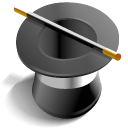Wayne Dobson
Wayne Dobson (born 5 July 1957, Leicester, England) is an English magician who became well-known through various television appearances in the late 1980s and 1990s. At the height of his fame he had his own television series Wayne Dobson - A Kind of Magic. More recently he has become known as a campaigner for multiple sclerosis charities.
Early life and magic career
Dobson was born in Leicester and developed an interest in magic at an early age. He has attributed the start of this interest to experiences including seeing an entertainer at a children's party and watching television programmes such as the David Nixon show. When he was nine his parents gave him a David Nixon Magic set as a Christmas present and thereafter he became a dedicated performer always seeking to learn new tricks. During a school trip to London to visit the British Museum he stumbled upon the Davenports magic shop, to which he would return often during his teens as he sought to learn more about professional magic. At Davenports he met magician Pat Page who became a mentor and lifelong friend. Other influences cited by Dobson include Roy Johnson, Ken Brooke and Dai Vernon, who was revered among magicians for his close-up magic.[1]
At the age of 16, Dobson became the youngest ever member of the Leicester Magic Circle. He also started to pick up work on a semi-professional basis at local clubs. In 1977 he won joint first prize in the close-up competition at the International Brotherhood of Magicians British Ring Convention. This led to his television debut on the BBC Television show Blue Peter. Encouraged by this success Dobson decided at the age of 21 to become a full-time professional magician.[1]
Dobson had developed a style of magic based around fast-talking patter and one-liner humour. It won him work as an opening act on tours with top UK performers such as Freddie Starr, Shirley Bassey and the Shadows. He also began getting guest slots on television shows. In 1988 he was hired as a support act for Engelbert Humperdinck on a tour of America, where he won positive attention and got experience of major entertainment centres such as Las Vegas. Back in the UK he was asked to perform in the 1989 Royal Variety Show at the London Palladium, where he scored a great success with an act in which he was assisted by boxer Frank Bruno and sports commentator Harry Carpenter. Later that year he made regular guest appearances on the Joe Longthorne television show. This led to him being offered his own TV series. Wayne Dobson - A Kind of Magic was aired nationally on Saturday nights on the ITV network with Linda Lusardi as his assistant and at its high point had audiences of 11 million. In total, three series were commissioned.[1] In 1994 he briefly quit the Magic Circle after it refused to dismiss an unnamed rival whom Dobson had accused of stealing a trick.[2]
Multiple sclerosis
Dobson was diagnosed with multiple sclerosis (MS) in 1988. Although he knew this would eventually come to limit his mobility he determined to carry on working to his fullest potential. He also became an ambassador for the Multiple Sclerosis Resource Centre (MSRC) charity.[3]
Later career
Having reduced his performing work because of the advance of his MS, Dobson has continued with a successful career in magic. Being highly regarded among fellow professionals he found himself in demand as a lecturer at societies and conferences. He runs DTRIK, a business developing and marketing magic tricks.[1]
References
- "Magic profile: Wayne Dobson". magicweek.co.uk. Retrieved 2008-06-17. and "Profile". WayneDobson.co.uk. Retrieved 2008-06-17.
- The Sun 30 April 1994
- "New ambassador role for Wayne Dobson". Multiple Sclerosis Resource Centre. Archived from the original on 2009-02-18. Retrieved 2015-03-25.
